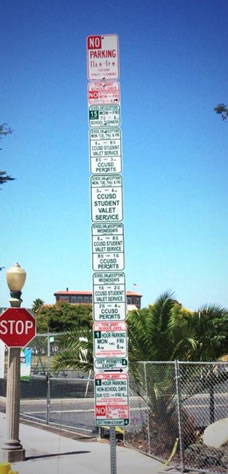ADVERTISEMENT
November 2015
The Situation
Imagine you are pressed for time and looking for a place to park. Will you stop and decipher this confluence of information (See Figure 1) or ignore it and drive on in search of a simple “Visitor Parking” sign?

Figure 1. Street signs (Rand, 2014)
This visual represents the way compound and/or complex sentences appear to many English language learners (ELLs) and leads to the same “shut down” reaction most of us had. Many adolescent ELLs will accept this experience as one more example of their lack of ability with academic English. The following dialogue provides a window into the mind of a long-term ELL (LTELL) upon reading a passage containing compound and complex sentences:
Researcher: Tell me what went through your mind when you began to read this paragraph.
LTELL: I got most of the words but together it didn’t mean nothing. You know, it was just like a really long sentence with a bunch of commas and I didn’t think it would get any better so I skipped the rest and went to the next paragraph.
Researcher: How was that going to help?
LTELL: I don’t know, I guess I thought it might clear up what was going on in this paragraph.
Progress reports stated this student was “in danger of failing the class” and “unmotivated.”
Current Strategies
In many language development materials, students learn about various sentence structures by labeling sample sentences as simple, compound, or complex. In another exercise, students practice combining simple sentences. Many students, especially those literate in their first language or those in well-articulated English language development programs, benefit from these tasks. Unfortunately, these practices do not always transfer to improved academic literacy skills, especially for the growing number of adolescent LTELLs who have become “failure-accepting” (Zakrzewski, 2013).
Sentence Dissecting Strategy
Audience
The following strategy gives secondary ELLs the confidence to “read and comprehend complex literary and informational texts independently and proficiently” (National Governors Association & Council of Chief State School Officers, 2010, p. 10); such texts are composed largely of sentences with multiple clauses. This technique can benefit ELLs who are progressing but specifically targets LTELLs mired at the intermediate stage of academic English language development.
Materials: Chart paper, markers (including red), multiple copies of a complex sentence containing key information on the topic being studied.
Strategy Implementation
Note: implement only after the teacher has demonstrated the procedure and students have had time for ample guided practice.
Extension Activity
After the students have become proficient with dissecting sentences, try this extension activity:
Benefits
Student Sample of Sentence Dissecting
Sentence to Dissect: In an event leading to the outbreak of World War I, Archduke Franz Ferdinand, nephew of Emperor Franz Josef and heir to the throne of Austria-Hungary, was assassinated with his wife by a Serbian nationalist in Sarajevo, the capital of Bosnia, in 1914.
One Group’s Valid Responses
Summary of Results
I implemented this sentence dissecting strategy with a sample of 267 high school LTELLs over a 4-month period. The quantitative data showed significant improvement in comprehending a nonfiction academic passage with sentences containing multiple clauses. It also confirmed that “by taking the time to zoom in on an essential passage of a larger work, students gain insight into the entire text” (Fisher & Frey, 2015, p. 35).
Yet the most powerful results were the students’ written responses to a prompt asking them to describe if and how dissecting sentences helped them with their English. The most poignant statements were the following:
Student A: Yeah, you do better if you actually read it.
Student B: I don’t give up so much when I see a long sentence. I know how to tear it apart to make some kind of sense.
References
Fisher, D., & Frey, N. (2015). Close reading of complex texts with English learners. In L. C. De Oliveira, M. Klassen, & M. Maune, The Common Core State Standards in English language arts for English language learners grades 6–12 (pp. 25–38). Alexandria, VA: TESOL Press.
National Governors Association & Council of Chief State School Officers. (2010). Common Core State Standards for English language arts & literacy in history/social sciences, science, and technical subjects. Retrieved from http://www.corestandards.org/assets/CCSSI_ELA%20Standards.pdf
Rand, J. [ABC7Jory]. (2014, August 22). See the Culver City parking sign totem pole? Nobody can understand this thing! Our story: http://abc7.com/news/towering-parking-signs-in-culver-city-confuse-drivers/277413/ … @ABC7 [Tweet]. Retrieved from https://twitter.com/abc7jory/status/503046051033391105
Zakrzewski, V. (2013, December 5). How to help kids overcome fear of failure. Retrieved from http://greatergood.berkeley.edu/article/item/how_to_help_kids_overcome_fear_of_failure
|
Download this article (PDF) |
Elizabeth Hartung-Cole (MA TESOL from UCLA) specializes in training teachers and administrators in effective, research-based instruction for secondary long-term English language learners (LTELLs). Her positions have included: serving as English language development curriculum leader for a large urban school district, creating language arts course outlines amplified for LTELLS and approved by the University of California system, presenting at professional conferences, teaching LTELLS in a credit-retrieval program, participating on school accreditation committees, and teaching English internationally.
Adjunct EFL Instructors (Spring Semester), Clark University, China
Senior Lecturer, ESOL (Nontenure Track), Syracuse University, Syracuse, New York, USA
Director of ELI and Correspondence Education, Oklahoma State University, Stillwater, Oklahoma, USA
ESL Lecturer (Core Faculty Member), University of North Carolina at Charlotte, Charlotte, North Carolina, USA
To browse all of TESOL's job postings, check out the TESOL Career Center.